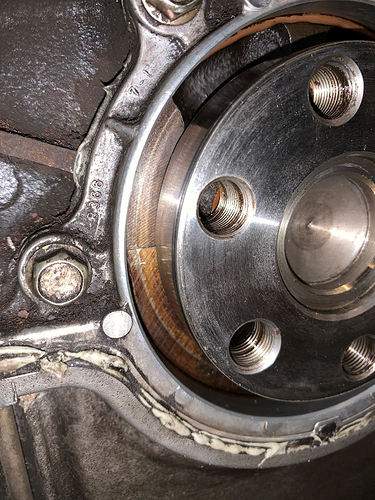You will need to Loctite the sleeve in place to make sure it doesn’t spin on the crankshaft.
Not if the correct size is fitted. They are a press fit.
I would always recommend Loctite as we have had them spin on train final drive input shaft seals and wear the shaft so it is then scrap. Better safe than sorry.
Sounds like a good idea to Loctite. If the seal is pressed a little tighter it might just work the sleeve off the crank and do damage there.
Threadlock should do it?
J
The theory we came up with was that the seal friction heated the thin sleeve up quicker than the shaft and so loosened the fit of the sleeve on the shaft. Bearing fit Loctite is better if you can get it.
Loctite grades are developed to do a certain job, so no don’t use thread lock.
Thanks for the info guys. The Loctite bearing stuff is quite pricey so think im going to get the Sealey alternative which seems the get good reviews and is a third the price!
Sealey SCS601S Bearing Fit Retainer High Strength 50ml https://www.amazon.co.uk/dp/B01NB1QCM9/ref=cm_sw_r_cp_api_i_7tOnFb4F7NFC5
Worth putting in the new spigot bearing I’m about to install on the flywheel? No other bearings likely to be used during my whole kit car build.
J
As I said in my initial post, I’ve fitted quite a few of these before. Just bear in mind that because the sleeve has to stretch very slightly to form an interference fit, it does tend to push off any sealant or locking fluid put on the shaft as it goes on.
Loctite Bearing Fit is specifically designed for press and shrink fit applications, it requires a total absence of air to achieve max strength. Using it eliminates the risk of the sleeve spinning due to differential expansion as the sleeve warms up in operation. I’ve seen this problem on quite a few gearboxes that then required new shafts. Just not worth the risk of not using it on a crankshaft sleeve where a spinning sleeve will ruin the crankshaft.
I use Loctite products quite regularly and there’s a bottle of red bearing fit on my garage shelf right now, alongside the blue stuff I use elsewhere. There’s no reason not to use a sealant on a repair sleeve, for a belt and braces approach if desired, apart from applying excess which might then be pushed back into the recess behind the end of the crank land. However, if a standard neoprene crankshaft seal causes enough frictional heat to expand a repair sleeve enough to spin against the shaft I’d be surprised; I’d suspect incorrect sizing so there wasn’t not enough of an interference fit in the first place.
An inner bearing race spinning on a gearbox shaft or an outer in the casing is a different issue and some do require an adhesive/sealant of some sort because there isn’t a good interference fit. The best approach is to follow the fitting advice of the manufacturer.
Here is an attached list from a company called M. Barnwell, they are the same as Speedi Sleeves.
Look up the size of the seal journal and it gives you an upper and lower limit that the sleeve will fit over, they come with a cup that is used to install the sleeve, the only problem you may have is the sleeve has a break off flange like the peak of a top hat this goes on first, so you may have a problem getting at it to break it off, you can put a bit of sealant under it but we don’t when we use them at work. We use them to repair the same area on cranks as you are doing except it’s normally for wear on Ford crossflow cranks. https://www.barnwell.co.uk/content/uploads/2017/08/Shaft-Repair-Kits-M-Barnwell-Services.pdf
It wouldn’t let me attach it so here’s the link to the PDF on their website.
Hi Folks,
All done, Speedie sleeve fitted (thanks Wrinkly for the info on this) 99% happy with the job I have done. It turns out that there isn’t a sleeve quite the correct size for the rear crank end so this one is a little too small and went on with quite a bit of clout from the tool. The sleeve stretched nicely and no need for any adhesive. This sleeve is on tight. The manufacturer states that adhesive is only required if the shaft is outside of the normal application range on the smaller side. Mine was way out of range, but on the bigger side, so no need for adhesive. Any adhesive would have been pushed off without a doubt.
FYI the Speedie Sleeve to use for the rear crank end is 99324
Took a lot of time and care to remove the flange with a suitable pair of needlenose pliers (my Leatherman was the best in the end) without causing any damage. With the flange gone I could then turn the sleeve fit tool backward and carefully knock the front lip of the sleeve flush with the end of the crank. (see Pic 1).
the 1% annoyance is that I managed to nick the outer seal surface slightly. (see pic 2) I was thinking that I could solve this by applying Loctite blue gasket sealant when I refit the oil seal. This should work as it is the non rotational side of the seal???
Good learning experience and also learnt to take my time! Cheers for your invaluable input folks.
J
I’m glad it got you out of the poo, I think if you put some sealant around the outside of the seal then I can’t see that being a problem, how do I know 
When we have one that’s too small we put the crank up on the crankshaft grinder and give it a lick.
Chris

